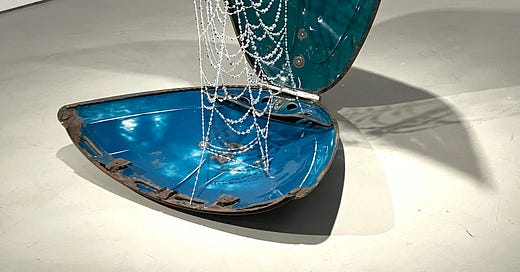The sculptures in this show can be divided into two groups: spidery and fruity. If you prefer technical-sounding language, you could call the groups 'open forms' and 'closed forms'. You could say one group is spare and the other excessive, one light and the other heavy. All are valid, but these terms are descriptive, not evaluative, so for the sake of criticism we might as well stick to plain old good and bad.
In the first group you'll find Generator II (cover image), a fantastical web of sparkling quartz beads spun between the hinged bonnets of two old Volkswagens. It takes the shape of a clam, but it's actually the house of a spider who lives in a Beetle. It's been decorated by a lively array of different agents: oxygen gave the factory-green metal its gorgeous orange patina; the quartz, made underground under immense pressure, is lifted into the air by the most delicate animal art. The imagination is welcomed in as the guest of honour.
The second group contains Bad Melon (Double Rainbow), two slices of an enormous orange melon whose skin is made from car metal, whose flesh is made from beads of an orange stone, whose coating of mould is the product of a plethora of crystals: agate slices, serpentine, jasper amongst many others.
It's spectacular, and like the Generator series it plays games with its material properties: crystal, a hard, durable thing, is co-opted to signify something soft and mushy. But it lacks the charm of the spider webs and adopts a overly familiar strategy. The transformation of precious and semiprecious stones into an even more expensive finished product that reminds us of decay is basically what Damien Hirst did when he made his diamond-studded skull.
It's a little confusing as to why this strategy needed repeating. Why so many crystals? Is it referring to the fact that even this kind of solid matter is in flux, albeit much slower than that of fruit? Perhaps it's because crystals are fashionable at the moment because people think they have magic powers. And, to be fair, Bad Melon has a magic of its own, although there's not much mystery about it.
Lacking the universality or the iconic clarity or the sheer record-breaking dollar-signs-in-your-eyes force of Hirst's For the Love of God, Bad Melon lacks critical distance from the nauseating atmosphere of pleasure in money for its own sake. Its magic trick is to illustrate the way wealth begets more wealth via contemporary art. The value of the stones has been increased by the artist. Invest in the art, and its value will go up too, and you can eat the fruit that never goes off, as long as you can tolerate the slightly unpleasant taste.




